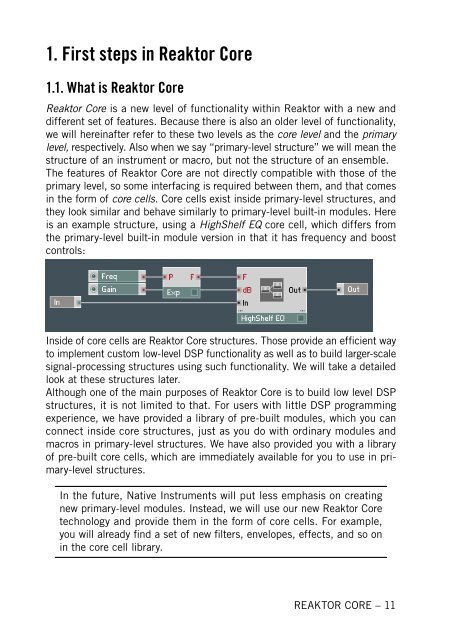1. First steps in Reaktor Core - Native Instruments
1. First steps in Reaktor Core - Native Instruments
1. First steps in Reaktor Core - Native Instruments
You also want an ePaper? Increase the reach of your titles
YUMPU automatically turns print PDFs into web optimized ePapers that Google loves.
<strong>1.</strong> <strong>First</strong> <strong>steps</strong> <strong>in</strong> <strong>Reaktor</strong> <strong>Core</strong><br />
<strong>1.</strong><strong>1.</strong> What is <strong>Reaktor</strong> <strong>Core</strong><br />
<strong>Reaktor</strong> <strong>Core</strong> is a new level of functionality with<strong>in</strong> <strong>Reaktor</strong> with a new and<br />
different set of features. Because there is also an older level of functionality,<br />
we will here<strong>in</strong>after refer to these two levels as the core level and the primary<br />
level, respectively. Also when we say “primary-level structure” we will mean the<br />
structure of an <strong>in</strong>strument or macro, but not the structure of an ensemble.<br />
The features of <strong>Reaktor</strong> <strong>Core</strong> are not directly compatible with those of the<br />
primary level, so some <strong>in</strong>terfac<strong>in</strong>g is required between them, and that comes<br />
<strong>in</strong> the form of core cells. <strong>Core</strong> cells exist <strong>in</strong>side primary-level structures, and<br />
they look similar and behave similarly to primary-level built-<strong>in</strong> modules. Here<br />
is an example structure, us<strong>in</strong>g a HighShelf EQ core cell, which differs from<br />
the primary-level built-<strong>in</strong> module version <strong>in</strong> that it has frequency and boost<br />
controls:<br />
Inside of core cells are <strong>Reaktor</strong> <strong>Core</strong> structures. Those provide an efficient way<br />
to implement custom low-level DSP functionality as well as to build larger-scale<br />
signal-process<strong>in</strong>g structures us<strong>in</strong>g such functionality. We will take a detailed<br />
look at these structures later.<br />
Although one of the ma<strong>in</strong> purposes of <strong>Reaktor</strong> <strong>Core</strong> is to build low level DSP<br />
structures, it is not limited to that. For users with little DSP programm<strong>in</strong>g<br />
experience, we have provided a library of pre-built modules, which you can<br />
connect <strong>in</strong>side core structures, just as you do with ord<strong>in</strong>ary modules and<br />
macros <strong>in</strong> primary-level structures. We have also provided you with a library<br />
of pre-built core cells, which are immediately available for you to use <strong>in</strong> primary-level<br />
structures.<br />
In the future, <strong>Native</strong> <strong>Instruments</strong> will put less emphasis on creat<strong>in</strong>g<br />
new primary-level modules. Instead, we will use our new <strong>Reaktor</strong> <strong>Core</strong><br />
technology and provide them <strong>in</strong> the form of core cells. For example,<br />
you will already f<strong>in</strong>d a set of new filters, envelopes, effects, and so on<br />
<strong>in</strong> the core cell library.<br />
REAKTOR CORE – 11










